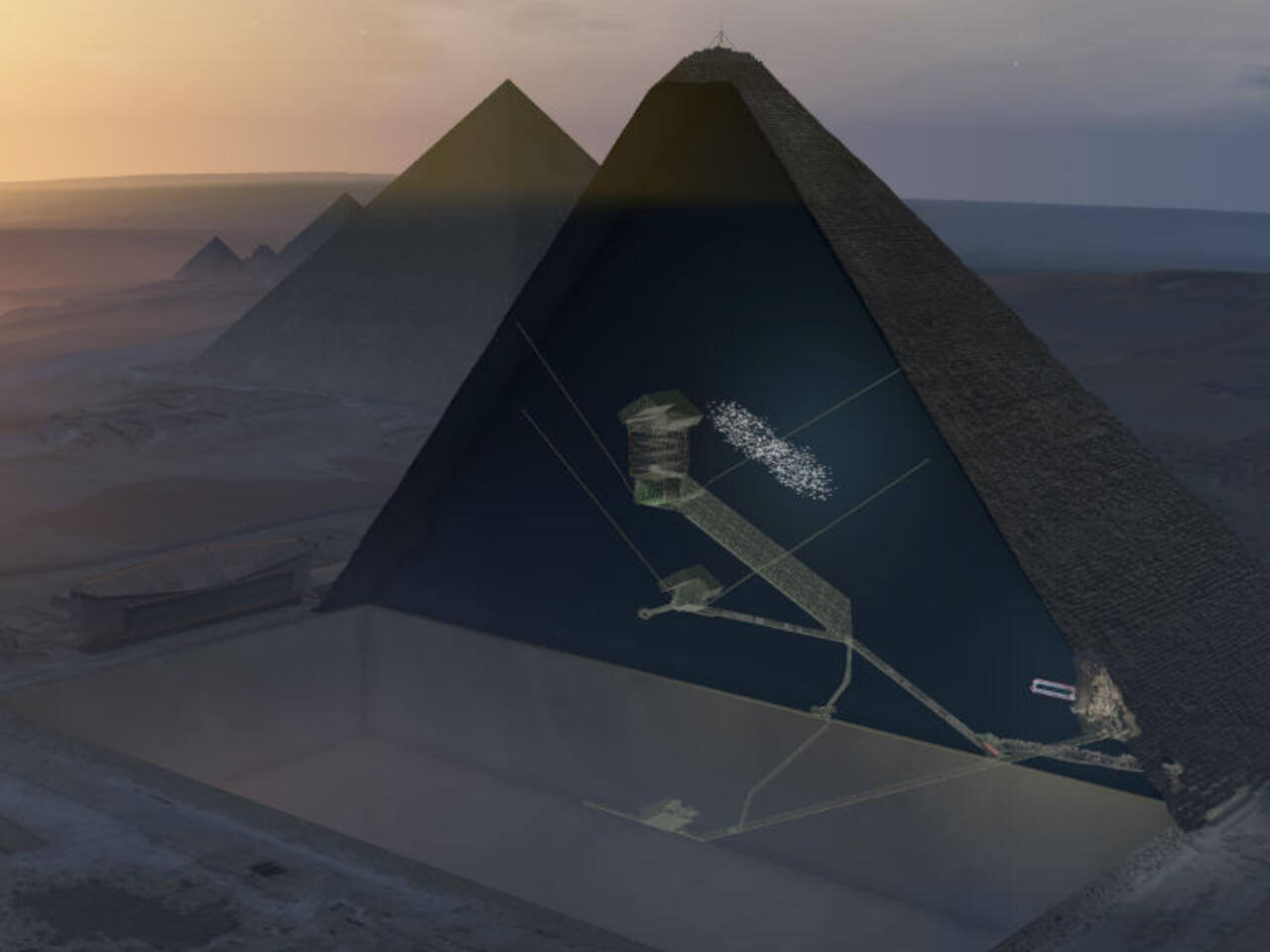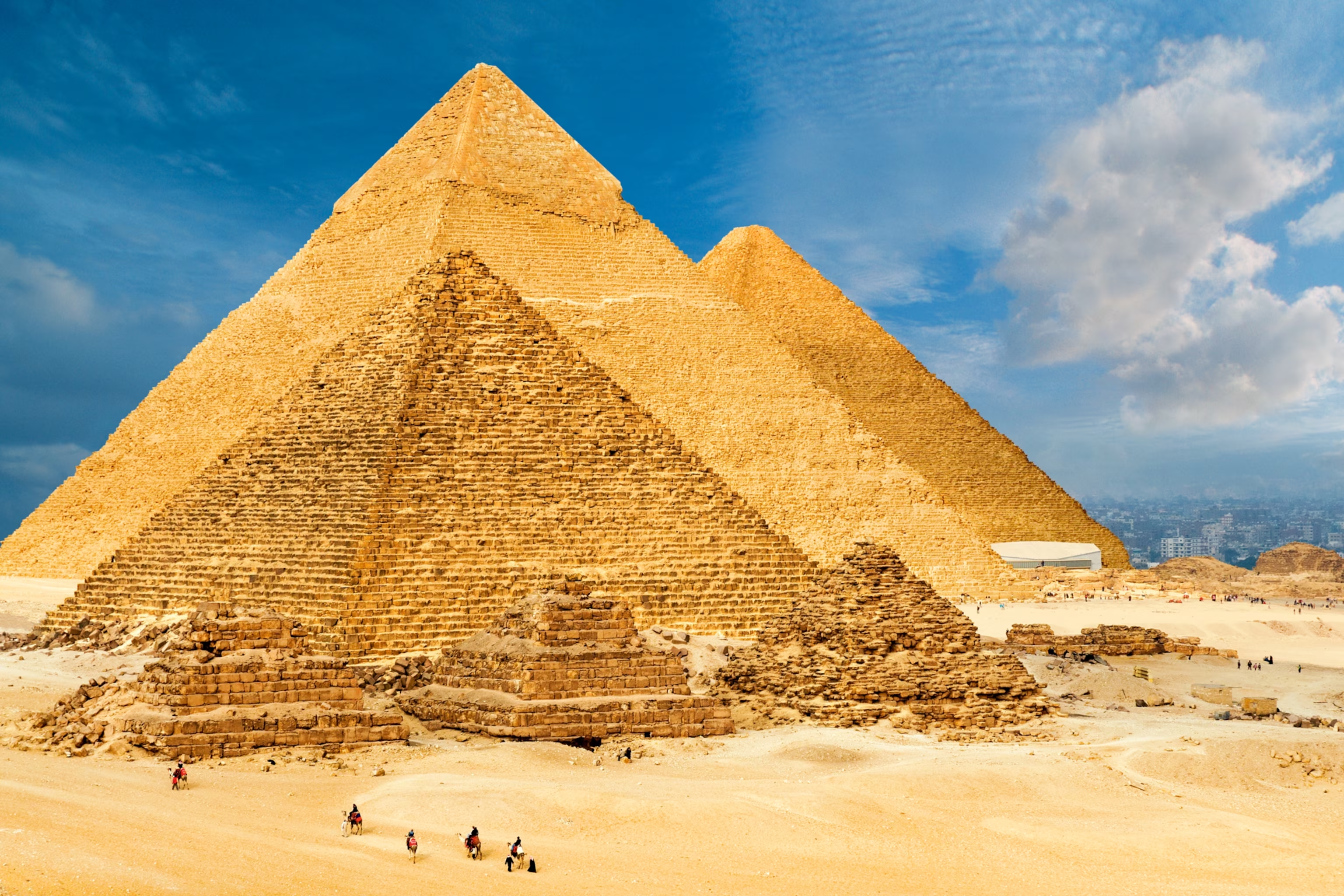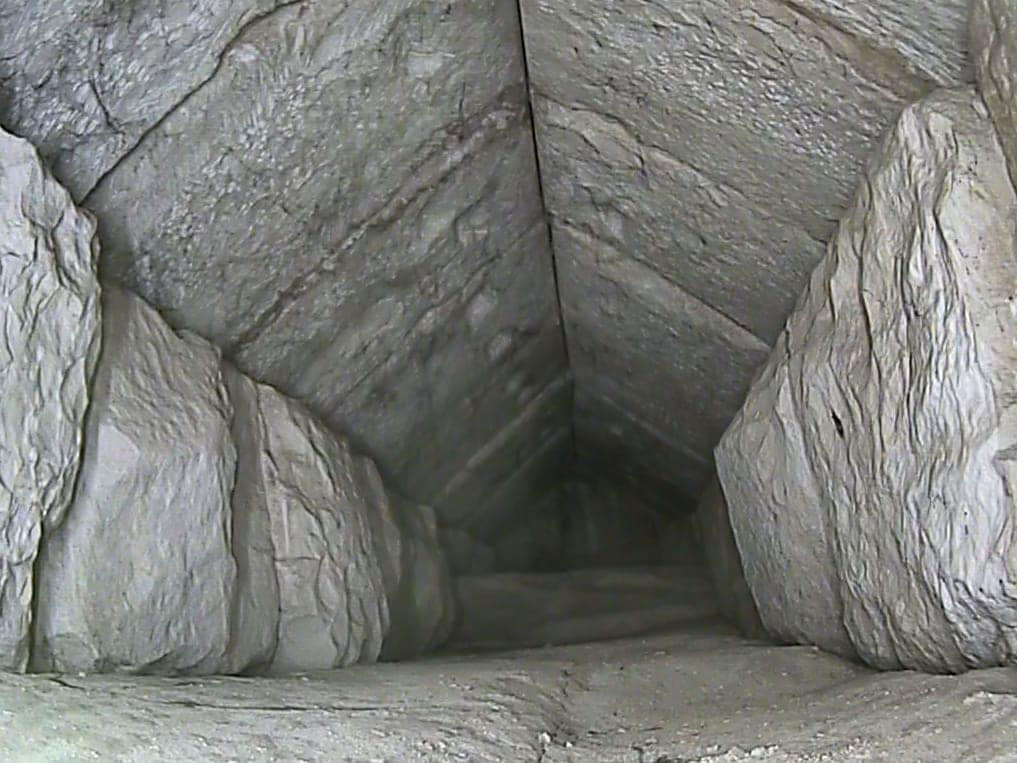The Great Pyramid of Giza has been the world's most difficult building puzzle for more than 4,500 years. This monument was built during the reign of Pharaoh Khufu, around 2580–2560 BCE. It is the only surviving wonder of the ancient world. The pyramid's imposing outside has been studied for hundreds of years, but its inside still holds secrets that make us question what we know about how the ancient Egyptians built things.
Recent advances in technology have changed the way we can look inside these old buildings without hurting them, showing hidden rooms and voids that have caused a lot of scientific debate and excitement in archaeology. This exploration looks into the known chambers, new discoveries, disputed claims, cutting-edge technologies, and the ongoing mysteries surrounding the Great Pyramid's internal architecture.

The Known Architecture: A Foundation of Mystery
For hundreds of years, people have known about the Great Pyramid's documented internal structure, but it is still the only one of its kind in Egypt. There are a number of well-known rooms and passages in the monument:
The King's Chamber is in the middle of the pyramid. It is made entirely of red granite and has a broken sarcophagus inside. People thought that this room was Pharaoh Khufu's final resting place, but no remains have ever been found.
The Queen's Chamber is below the King's Chamber, even though its name has nothing to do with royal burials. Egyptologists still argue about what it was for.
The Grand Gallery is a beautiful hallway that goes up and has a corbelled ceiling that is 28 feet high. This amazing building shows off advanced engineering that was used hundreds of years before similar methods were used.
The Subterranean Chamber is still not finished and is carved into the bedrock under the pyramid. This could mean that the plan was abandoned or that it was a planned design element.
These known structures make up only a small part of the pyramid's total volume, which makes researchers think that there are more hidden spaces inside the huge stone building.
Revolutionary Discoveries: What Happens When Cosmic Rays Hit Old Stones
The ScanPyramids project, which started in 2015 and is an international effort, has made the biggest progress in pyramid research. It uses non-invasive technologies to look inside the pyramid. Their findings have completely changed how we think about the structure of the monument's interior.
The North Face Corridor: A Discovery That Was Exactly Measured
In March 2023, scientists said they had fully mapped out a secret corridor behind the pyramid's north face. This corridor was first found in 2016. The French Alternative Energies and Atomic Energy Commission (CEA) and teams from Nagoya University in Japan used cosmic-ray muon radiography to make a very accurate map of this area.
The corridor is about 9 meters long, 2 meters wide, and 2 meters high. It is located just behind the chevron-shaped structure on the north face of the pyramid. The corridor is about 20 meters above the ground and looks like it is going north-south.
This is the first major internal structure found in the Great Pyramid since the 1800s. Mostafa Waziri, head of Egypt's Supreme Council of Antiquities, thinks that the corridor probably helped spread the weight of the pyramid, which is made up of 2.3 million stone blocks that weigh more than two tons each.
The "Big Void": A Mystery as Big as a Cathedral
The "Big Void" or "ScanPyramids Big Void," which was found in 2017, is probably the most interesting thing that has been found. This big hole is above the Grand Gallery and has a cross-section that is similar to that famous hallway. It is at least 30 meters long.
Three different muon detection methods were used to find the Big Void, which is strong proof that it exists. There are many theories about what it is for, though. Some say it is a structural feature meant to relieve pressure, while others say it is a hidden burial chamber full of artifacts that have not yet been found.

Cosmic Archaeology: The Science Behind the Discoveries
Muon radiography, a method that uses cosmic radiation to look through solid objects, is what makes it possible to find these hidden chambers. When high-energy cosmic rays hit Earth's atmosphere, they create muons, which are elementary particles. These particles fall to the ground all the time and can go deep into structures.
How to Find Muons
Muons move through empty space much more easily than through solid objects. This lets scientists find changes in density by measuring muon flux at different angles. Researchers can find places where fewer muons were absorbed by putting detectors inside the pyramid and measuring how many muons come from different directions. This shows that there are voids or less dense materials there.
Nobel Prize-winning scientist Luis Alvarez first tried the method on pyramids in the 1970s. Since then, improvements in detector technology have made it much more sensitive and accurate.
Accuracy of Technology
The accuracy of modern muon detectors is amazing. The ScanPyramids team used nuclear emulsion films from Nagoya University and gaseous detectors from CEA to measure the size and position of the corridor with an accuracy of a few centimeters. This is the first time that cosmic-ray muon radiography has been able to accurately describe the size and location of a void.
Claims that are not well-supported and scientific doubt
Not all claims about secret rooms have held up under scientific scrutiny. In 2025, there were rumors about huge structures underground under the Giza plateau, but mainstream Egyptology has completely disproven these.
Dr. Zahi Hawass, who used to be Egypt's minister of antiquities, said that claims about a huge hidden network of chambers and tunnels under the Great Pyramid were "completely wrong" and not based on science.
According to a 2022 paper that used Synthetic Aperture Radar (SAR), there were "five identical structures near the base of the Khafre Pyramid, connected by pathways, and eight deep vertical wells descending 648 meters underground." Snopes and other fact-checking groups, on the other hand, did not find any credible evidence to back up these claims.
Why Peer Review is Important
These arguments show how important peer-reviewed research is in archaeology. Even though the ScanPyramids findings have been published in well-known journals like Nature Communications, the extraordinary claims about huge underground cities don't have enough scientific proof.
Construction Theories: Amazing Engineering and Ongoing Debates
The discovery of hidden chambers adds new dimensions to long-standing debates about how pyramids were built. There are many different ideas about how the ancient Egyptians built these monuments:
The Ramp Theory
The most widely accepted theory is that huge limestone blocks were carved from quarries and then moved into place using ramps. Recent discoveries at the Hatnub quarry showed that ramps can be steeper than 20 percent, which is more than what was thought possible before.
Theories in Hydraulic Engineering
New research shows that the ancient Egyptians may have used advanced hydraulic systems to move stones, using water-driven pressure systems that worked like simple elevators. Scientists recently found the "Ahramat Branch," a branch of the Nile River that is now buried. It probably brought materials to the sites where pyramids were built.
Hypotheses About Internal Ramps
French architect Jean-Pierre Houdin said that pyramids were built with spiral ramps inside. His theory posits an external ramp for the initial 30% of construction, succeeded by an internal ramp system to elucidate the lack of external ramp evidence.
Concrete Theory
Some scientists, led by Michel Barsoum at Drexel University, think that the stones used to build the pyramids were cast instead of carved and moved. They think this was done with an early type of concrete made from limestone, clay, lime, and water. This theory is still up for debate, but it could explain why some stones fit so well.
New Peripheral Discoveries: Adding to the Mystery
Recent discoveries around the Giza plateau, in addition to the pyramid itself, help us understand more:
Researchers from Japan and Egypt used ground-penetrating radar to find an L-shaped structure and an unusual feature in the Western Cemetery near the Great Pyramid. We don't know what this underground structure is for, but it could be an entrance to deeper chambers.
Dating and Cultural Context
Archaeological finds in 2025 included Nubian skeletons that were hundreds of years older than the pyramids. This suggests that the Giza plateau's growth was part of a larger cultural picture. These findings show that the site was important even after the pyramids were built.

The Technology Revolution in Archaeology
The finds at Giza show how new technology is changing the way archaeologists work:
Investigation That Doesn't Harm
Researchers can look into ancient buildings without damaging them thanks to modern tools like muon radiography, infrared thermography, and ground-penetrating radar. This is a big change from 19th-century archaeology, when digging often meant destroying things.
3D Modeling and Simulation
Researchers can now make exact 3D models using laser scanning and photogrammetry. This lets them look closely at and explore spaces that may never be physically accessible.
Working Together Across Borders
The ScanPyramids project is an example of modern archaeological teamwork, with teams from Egypt, France, Japan, and other countries working together. This global approach brings together a wide range of skills and checks the results.
Unsolved Questions and Future Research
Even with these amazing discoveries, there are still some basic questions about the Great Pyramid that need to be answered:
Purpose and Function
We don't know exactly what the newly found corridors are for. Some people think they are for distributing structural weight, while others think they are for religious or astronomical purposes. Dr. Zahi Hawass thinks that there may be "something important underneath the corridor," which could be Khufu's real burial chamber.
Order of Construction
The hidden chambers make us think about the order in which things were built. Did someone plan for these voids, or are they just necessary for construction? How do they fit into the pyramid's overall design?
Getting there and looking around
Future research may utilize small-diameter boreholes for direct examination of concealed chambers; however, these invasive methodologies necessitate meticulous consideration of conservation issues.
Balancing Science and Preservation: Conservation vs. Discovery
Modern archaeologists have to make tough choices about whether to explore or leave these irreplaceable monuments alone. The Great Pyramid is more than just an archaeological site; it is a world heritage treasure that needs to be protected.
Ethical Concerns
Any future exploration must find a balance between scientific curiosity and respect for the monument's integrity and Egyptian cultural heritage. The current plan is to keep scanning without touching anything so that we can get as much information as possible before thinking about making any changes.
Debunking Pseudoscience: Why Research Should Be Based on Evidence
Sadly, the discoveries about the pyramids have led to a lot of pseudoscientific ideas, like aliens building them or lost technologies. However, ancient papyri show that building pyramids was "a very large logistical undertaking, but just a building project nonetheless."
Modern archaeology shows that pyramids were built by skilled workers who were paid and worked in groups, not by slaves as was once thought. These workers left behind a lot of proof of their villages, tools, and methods.
Looking Ahead: What Will Happen to Pyramid Research in the Future
As technology improves, the Great Pyramid keeps giving up its secrets. Future research directions encompass:
Better Muon Detection
New muon telescope systems could be 100 times more sensitive than current ones. This could help them find smaller voids and take better pictures.
Analysis of Artificial Intelligence
Machine learning algorithms might be able to find patterns in data that human researchers miss, which could lead to the discovery of more hidden structures.
Integrated Approaches
Using more than one non-invasive method, like muon radiography, ground-penetrating radar, magnetic surveys, and 3D modeling, gives a complete picture of internal structures.
Conclusion: Old Mysteries in the Modern World
The secret rooms in the Great Pyramid are more than just interesting archaeological finds. They show how advanced the engineering skills of ancient Egyptians were and how modern technology can reveal secrets that have been hidden for thousands of years.
Using cosmic-ray muons to get an exact measurement of the North Face Corridor is a huge step forward for both archaeology and international scientific cooperation. These findings show that even the most studied monuments in the world can still surprise us.
As more research is done, each new finding brings up new questions about what the ancient Egyptians could do, how they built these amazing buildings, and what their real purpose was. The Great Pyramid is still what it has always been: a puzzle that keeps us from fully understanding the past and a testament to human ambition and creativity.
The hidden chambers show us that archaeology isn't just about finding out what happened in the past; it's also about figuring out how people in the past dealt with tough problems with the tools and knowledge they had. By revealing these secrets, we learn about the past and get ideas for how to deal with problems in the present.
The Great Pyramid is not a relic of a primitive past; it is proof of humanity's ability to innovate, be precise, and achieve great things. As technology continues to improve, who knows what other secrets these ancient stones might still hold?
